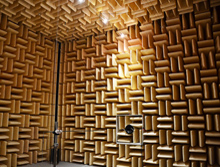Industrial soundproofing is a major activity for ITS, whether it involves studies (including: measurements, R&D, calculation software, design) or the marketing of solutions, in relation to the various issues in all sectors of activity.
Main applications are the protection of workers against noise, the preservation of acoustic environment, the limitation of noise emissions in energy sector and testing rooms acoustics.
Protection of workers against noise
Industrial soundproofing, as practiced by ITS in this field, is not unrelated to the fact that, in industry as in other sectors of activity, noise is one of the problems relating to the working conditions in relation to which employers must make efforts to meet the regulatory obligations to which they are subject in order to protect workers against noise exposure.
The Decree No. 2006-892 of 19 July 2006 on the safety and health requirements applicable in the event of exposure of workers to the risks arising from noise and amending the Labor Code, which transposes into French law Directive 2003/10/EC fixed in Article 231-127. - I. - exposure limit values - that is, a daily noise level of 87 dB(A) or a peak sound pressure level of 140 dB(C) - and exposure values that trigger prevention action - that is, a daily noise exposure level of respectively 80 dB(A) and 85 dB(A) or a peak sound pressure level of respectively 135 dB(C) and 137 dB(C) depending on the nature and reach of the action.
The Oder dated 30 August 1990 adopted for the application of Article R. 235-11 of the Labor Code and relating to the acoustic correction of work premises, sets meanwhile, the minimum characteristics that these premises must have. in order to reduce the reverberation of the noise on the walls when this one would appreciably increase the level of noise exposure of the workers, in term of decay of the sound level by doubling of distance to the source, namely 2 dB(A) to 4 dB(A) according to the floor area of the room and whether it is an empty room without any machine or production facility or whether it is a room after installation of machinery and production equipment. When useful before or after the implementation of absorbent linings (in the first case: to carry out a control or an expertise, to evaluate the conformity of a space and - if necessary - to contribute to the development of action plans; in the second case: to quantify and verify the performance of the reverberation treatment after implementation), measurements of acoustic indicators subject to regulation can be made by ITS according to dedicated standards e.g. ISO 14257 Acoustics - Measurement and parametric description of spatial sound distribution curves in workrooms for evaluation of their acoustical performance.
With regard to offices (e.g. individual or collective, open spaces), the standard NF S 31-080 Acoustics - Offices and associated areas - Levels and acoustic performance criteria by type of space (the application of which is not mandatory ) is the reference in France for taking into account the acoustic quality of such workspaces, frequently encountered in industry, on the basis of various performance indicators, including the overall sound level, the reverberation time or spatial noise decay, iunsulation from interior noise, distinguishing 3 levels (of quality): current level, performant level, and very performant level.
|
noisy |
The protection of workers against noise is one of the main activities of ITS in the field of industrial soundproofing. |
ITS is involved in the definition and implementation of programs of technical measures to reduce noise exposure, whatever they are and in all contexts. Enclosures for machines and production lines, noise-absorbing enclosures and carterizations, and also silencers are for ITS common ways of reducing noise at the source in many industries, while absorptive screens and noise barriers are equipment opposing the propagation of noise e.g. in workshops and while soundproof booths are an effective way to protect operators when working conditions allow e.g. in the printing industry, in the glass manufacturing industry. The installation of absorbent linings (panels, tiles whose absorption coefficient can reach 100% at medium-high frequencies) on the walls or under the roof of a room (in the form of suspended ceiling, or baffles) is also a technique to which ITS recourses to control the reverberation of industrial premises.
|
|
An enclosure of a machine by means of soundproofing panels, with doors and acoustic glazed frames, and with silencers for ventilation is an effective industrial soundproofing device. |
|
|
|
|
A soundproof workshop office is a good mean of protection of employees against noise in an industrial environment. office offers good working conditions in a workshop, especially for tasks requiring protection from excessive noise. |
Preservation of acoustic environment
Industrial soundproofing, as practiced by ITS in this field, has to do with the fact that industrial establishments must avoid noise pollution for the neighborhood.
The Decree of 23 January 1997 on the limitation of noise emitted into the environment by Facilities Classified for the Protection of the Environment (FCPE) sets the provisions for noise emissions from industrial sites. In particular, it is based on the concept of emergence i.e. the difference between the A-weighted equivalent continuous pressure levels of the ambient noise (establishment in operation) and the residual noise (in the absence of the noise generated by the establishment) in Zones with Regulated Emergence (ZER, in the near environment), and distinguishes the daytime period (07:00 to 22:00 except Sundays and public holidays) and the night period (22:00 to 07:00 as well as Sundays and public holidays): the admissible emergence is 6 dB(A) in the daytime period and 4 dB(A) in the nighttime period if the ambient noise level in the ZERs (including the noise of the establishment) is between 35 dB(A) and 45 dB(A); the permissible emergence is 5 dB(A) in the daytime period and 3 dB(A) in the nighttime period if the ambient noise level in the ZERs (including the noise of the establishment) is greater than 45 dB(A) .
The concept of marked tonality, whose presence is related to the difference between the sound pressure level in a given 1/3 octave frequency band and the adjacent frequency bands, which is considered undesirable if it exceeds 10 dB in the frequency range 50 Hz-315 Hz or 5 dB in the frequency range 400 Hz-8000 Hz is also taken into account, and in addition, in certain cases, a prefectural decree (when it is not ministerial) sets the noise levels not to be exceeded in the property limit e.g. 70 dB(A) during the daytime period and 60 dB (A) during the nighttime period in many cases.
|
neighborhood |
Preserving the environment with regard to noise emissions from industrial sites often motivates the recourse to ITS. |
ITS is involved in the design and implementation of soundproofing equipment, regardless of the principle on which their effectiveness is based and regardless of the situation that prevailed that they are considered. Sound-insulated hoods, duct lining, silencers for pressurized fluid networks or for ventilation equipment (fans, refrigeration units, air-condensers, air conditioners) and acoustic screens are for ITS typical industrial soundproofing methods, as are soundproof buildings. when it comes to acoustic protection against noise sources being large or dispersed in a large interior space.
|
|
|
Enclosures (soundproofing hoods) and acoustic screens made from modular metal industrial soundproofing panels make it possible to reduce the noise of many materials at the source. |
|
|
|
Silencers for Heating Ventilation Air Conditioning (HVAC) installations and for dust removal networks, extractions from paint booths make it possible to limit the propagation of noise towards the neighborhood without opposing the passage of air. |
|
|
Lining of ducts and pipes makes it possible to reduce the transmission of noise through the walls of aeraulic or pressurized fluids networks. |
It may be mentioned that in some cases of machines with a very high sound power level, soundproofing equipment necessary to prevent operators from being in a situation of auditory trauma can also be a good way to avoid (sound) annoyance of the neighborhood. Thus, the installation of an enclosure of a concrete press, a punch press, a press in the field of metal processing, or a single face machine in the sector of the manufacture of cardboard can be motivated by the dual concern of protecting workers and preserving the environment, especially in the event of a complaint. This double concern is quite general for sound insulation projects in the power generation sector when it comes to the construction of a soundproof building housing for example a gas turbine or a generator.
Where necessary before or after noise reduction works (in the first case: to carry out a diagnosis, to assess the conformity of a facility and - where appropriate - to contribute to the development of action plans; in the second case: to quantify and verify the performance of acoustic insulation after implementation), measurements of acoustic indicators subject to regulation can be performed by ITS according to dedicated standards e.g. NF S31-010 Acoustics - Characterization and measurement of environmental noise - Special methods of measurement.
Limitation of noise emissions in energy sector
Industrial soundproofing, as practiced by ITS in this area, is not unrelated to the fact that, in the energy sector (production and distribution), at the same time:
- the sources of noise are among the noisiest (e.g. air intake and exhaust of burnt gases from combustion turbines, heat engines, discharge vents downstream of pressurized fluid networks) and/or often have extraordinary dimensions (several hundred square meters of floor space for constructions intended to reduce the noise of the body of large capacity-compressors, turbines, Heat Recovery Steam Generators)
- the objectives are generally very ambitious in terms of limiting noise emissions, combining - very often - the requirements related to the protection of workers against noise and those related to the preservation of the acoustic environment
- the challenges are particularly important with regard to the consideration of constraints relating to site (including those resulting from taking account local standards, regulations, and engineering or manufacturing codes) and those related to the process, to necessary related functionalities (e.g. filtration, ventilation, electrical works) and to requirements for design optimization, construction and associated documentation quality, as well as for meeting deadlines
This is why industrial soundproofing for the limitation of noise emissions in the energy sector is a somewhat separate market, for which, at a global level - when it comes to very large projects - the number of players able to offer, everywhere and always, complete solutions meeting all kinds of requirements are ultimately quite small.
|
the limitation of noise emissions |
The protection of workers against noise and the preservation of the acoustic environment are often the two fundamental aspects of industrial soundproofing projects for the limitation of sound emissions in the energy sector in which ITS participates. |
ITS and its business partners serve many international customers in the field of the limitation of noise emissions in the energy sector by offering the required specific industrial soundproofing hardware: large-sized, with high acoustic performance canopies and buildings with soundproof ventilation systems, noise barrier walls, silencers of all kinds e.g. for fluids at ambient temperature (in particular for the air intake of compressors, engines, turbines) or for very high temperature applications (e.g. exhaust gas, steam).
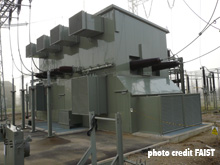
enclosure for a transformer |
acoustical screen (noise barrier wall) for a transformer |
An enclosure allows noise reduction at source by reducing the sound power level of noisy hardware (which is an intrinsic characteristic), while an acoustical screen (noise barrier wall) limits sound propagation, allowing the reduction of the sound pressure at specified locations (which depends on the distance to the noise source under consideration, sound propagation conditions, and environmental characteristics). For applications in the field of energy sector it is often a question of metal constructions. |
|
|
|
Discharge silencers for the venting of pressurized gases and exhaust silencers (for gas turbines i.e. combustion turbines, heat engines) are frequently implemented in the context of industrial soundproofing projects in the energy sector. |
Testing rooms acoustics
The industrial soundproofing, as practiced by ITS in this field, has to do with the fact that on the one hand the research and the development and on the other hand the characterization of the performances in terms of acoustics of hardware requires measuring rooms and specific test benches.If it concerns the determination of sound power levels and sound energy levels emitted by noise sources from sound pressure - Laboratory methods for anechoic rooms and semi-anechoic rooms, the standard ISO 3745 is often the reference, specifying methods for measuring sound pressure levels on a measurement surface surrounding a source of noise (machine or equipment).
Such a metrology requires free acoustic field conditions, which is achieved by the implementation of special absorbent linings and also sufficiently low (internal) background noise levels that can be obtained by the construction of envelopes with high performance in terms of limitation of the transmission of noise from the outside to the inside of a testing room, both airborne and solid (sometimes the walls of the envelope must also oppose the propagation of noise towards the outside if the test relates to a noise source of high acoustic power).
|
anechoic room |
The realization of acoustic measuring rooms and soundproof test benches is one of the specialties of ITS. |
ITS offers industrial soundproofing equipment dedicated to test benches and measurement rooms (among which: aero-acoustic wind tunnels): flat or non-flat acoustic absorption (wedges), acoustic insulation panels for the construction of removable enclosures, acoustic door sets are common components of such projects for ITS.
A comprehensive range of products and services for industrial soundproofing
Whether it concerns the protection of workers against noise exposure (including offices), the preservation of the environment with regard to noise pollution or the realization of test facilities, ITS proposes a complete offer in terms of industrial soundproofing, from engineering (if necessary: including on-site measurements) to turnkey realization (in relation with commercial partners) of projects in France or internationally.
The metrology and sound simulation tools of ITS can (with its personnel) be roped everywhere in France and in the neighboring countries to carry out a diagnosis and to find, in the field of industrial soundproofing in all sectors of activity, solutions featuring sound insulation equipment of the highest quality, whose performance is guaranteed, and which are produced by diversified business partners, all sharing with ITS human resource, the love of a job well done.
ITS intervenes in the field of industrial soundproofing: measures, studies, marketing solutions to avoid nuisances due to noise.
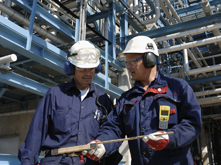
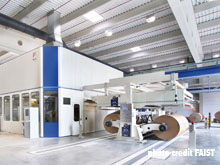 enclosure for a corrugator
enclosure for a corrugator 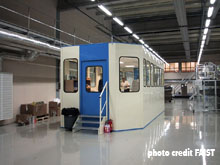 soundproofed control room
soundproofed control room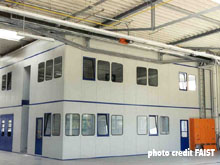 soundproofed workshop offices on 2 floors
soundproofed workshop offices on 2 floors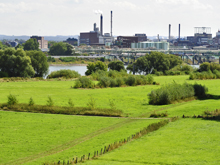
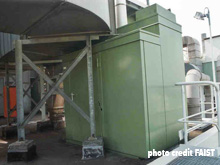 enclosure for a fan (chemical industry)
enclosure for a fan (chemical industry)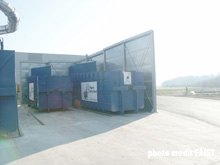 acoustical screen (paper industry)
acoustical screen (paper industry)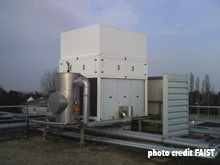 air outlet silenced system for an aerocondenser (pharmaceutical industry)
air outlet silenced system for an aerocondenser (pharmaceutical industry)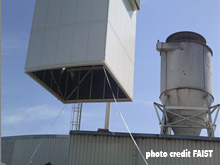 air outlet silenced system for a cyclone: under craning (corrugated cardboard industry)
air outlet silenced system for a cyclone: under craning (corrugated cardboard industry)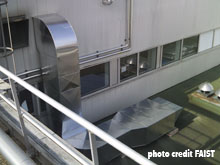 lagging of an air outlet duct (pharmaceutical industry)
lagging of an air outlet duct (pharmaceutical industry)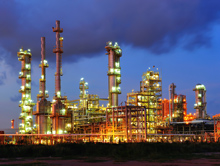
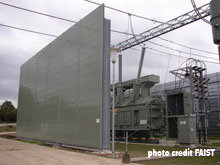
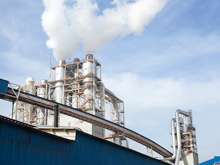 discharge / vent silencer
discharge / vent silencer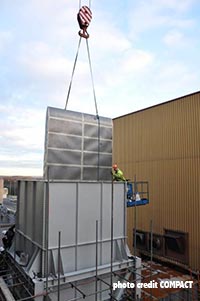 exhaust silencer for gas turbine (during installation)
exhaust silencer for gas turbine (during installation)